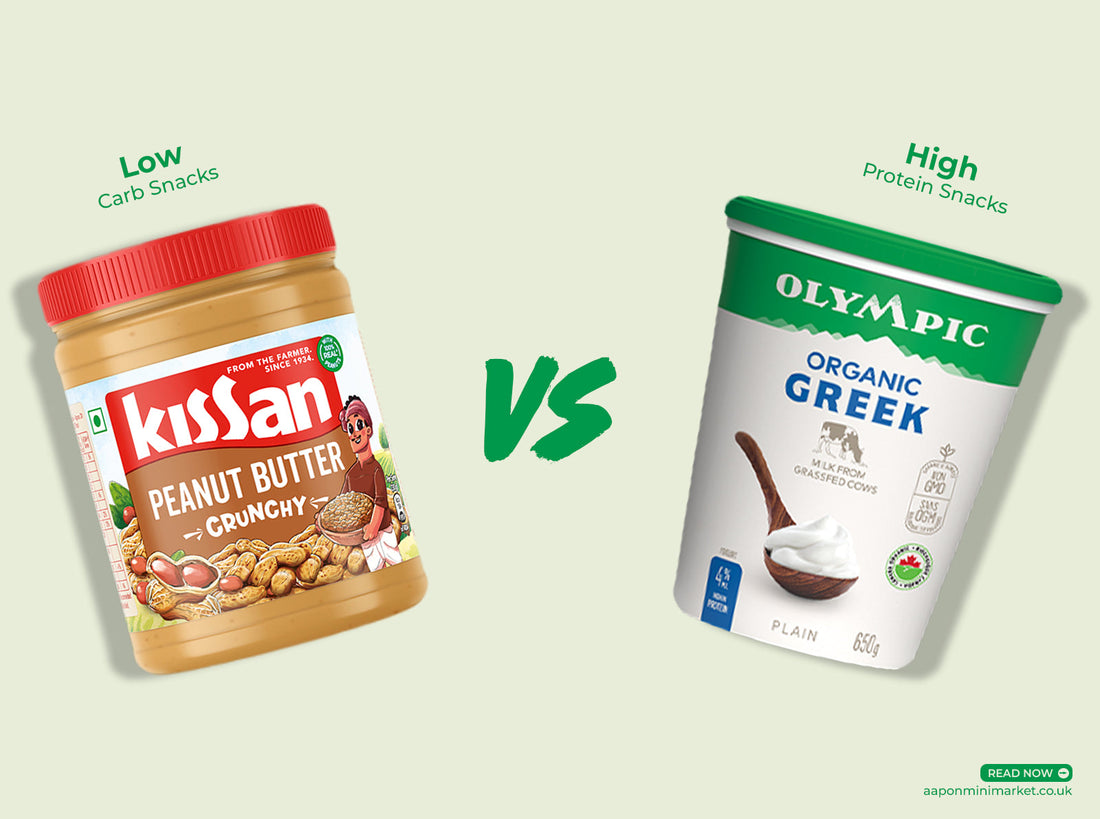Low-carb snacks are those that are concerned about low intake of carbohydrates, while high-protein snacks are concerned about increasing protein intake. People on a keto diet or with diabetes consume low-carb snacks.
People who want to maintain a healthy, balanced diet go for high-protein snacks. Low-carb snacks are good for reducing blood sugar, while high-protein snacks are important in muscle building. In a weight loss journey, low-carb and high-protein snacks play a crucial role and ensure a healthy lifestyle with a balanced diet.
What Are Low-Carb Snacks?
Low-carb snacks are mainly those types of snacks that contain a lower range of carbohydrates, like sugar or rice. These snacks mainly help to reduce extra body fat and enhance energy levels. Low-carb snacks lead to blood sugar stability and promote fat burning. The list of some low-carb snacks is linked below:
- Cold cuts (ham, turkey, chicken breast)
- Beef jerky (low sugar)
- Tuna or salmon pouches
- Cottage cheese (full-fat, no added sugar)
- Greek yogurt (plain, unsweetened)
- Nut butters (unsweetened)
- Pickles or gherkins
What Are High-Protein Snacks?
High-protein snacks are foods that are rich in protein and macronutrients for muscle building. High-protein snacks may satisfy extra cravings and enhance energy to work all day long. Some high-protein snacks are:
- Greek yogurt
- Tuna or salmon packs (in water or olive oil)
- String cheese or cheese blocks
- Hummus with veggies
- Roasted chickpeas – crunchy and protein-rich
- Tofu or tempeh cubes (pre-marinated or plain)
- Protein bars
- Protein shakes or drinks
- High-protein granola
Nutritional Comparison
|
Feature |
Low-carb snacks |
High protein snacks |
|
Main Focus |
Minimise carbohydrate intake |
Maximise protein intake |
|
Calories |
Moderate to high (depends on fat content) |
Moderate to high (varies by product) |
|
Carbohydrates |
Very low (often <10g per serving) |
Varies (can be low or moderate, e.g., 5–25g) |
|
Protein |
Varies; often moderate (5–12g) |
High (typically 10–30g per serving) |
|
Fat |
Often higher (especially in keto snacks) |
Can be low to high (depending on source) |
|
Fibre |
Can be low (unless veggies or nuts are included) |
Moderate (especially in bars or legume-based options) |
|
Energy Source |
Fat & protein |
Protein & sometimes slow-digesting carbs |
If you are aware of the nutrients that are very harmful to your health. Then you can explore our nutrition facts guide before you eat.
Choosing the Right Snack for Weight Loss, Muscle Gain & Recovery
Choosing the right snack depends on your body fitness and health objectives. If you are willing to lose some weight, then low-carb snacks are the right choice for you as they provide low carbohydrates that prevent extra body fat and cravings for meals. On the other hand, if you want to gain muscle and recover muscle, then high-protein snacks are right for you. These snacks help to recover muscle tissue, and high-protein foods are very helpful for gaining muscle.
Low-Carb Snacks for Fat Loss & Energy Control
Low-carb snacks are the best fit for those focused on weight loss, especially for a keto diet or a reduced sugar diet. These snacks enhance blood sugar and insulin response. Low-carb options provide steady fuel through protein and fats that help to reduce extra sugar and cravings for redundant meals.
So one can easily burn out their body fat as well as control steady energy to the body. Low-carb snacks such as boiled eggs, nuts, and seeds help to satisfy hunger and prevent one from consuming unhealthy snacks and meals. So if you want to lose fat, then low-carb snacks are going to be the best choice for you.
High-Protein Snacks for Strength & Muscle Repair
High protein snacks are for people who are looking to gain muscle, strength, and recover muscles. Regular gym-going people need to consume more protein than others. Healthy protein is mandatory in everyday meals. Greek yogurt, protein shake, cottage cheese, and eggs are a great source of high protein. These snacks instantly provide protein and help to fulfill daily needs.
Combining Both for Balanced Fitness
Combining both low carbs and high protein is one of the best strategies to achieve an overall healthy fitness, whether you are aiming for fat loss, muscle gain, or improved overall health. Low carbs help to stabilise blood sugar and support fat burning. On the other hand, high-protein snacks help to enhance muscle gain and repair body tissues after an everyday workout and diet.
So a combination of low-carb and high-protein snacks helps to balance fitness healthily. This helps to fuel your body without extra carbs, so you can achieve a fit body without any health issues. Rather, you will get a happy body with a healthy soul after combining these.
Best Picks from Aapon Mini Market
Aapon Mini Market provides all types of foods, including low-carb and high-protein options, so that all customers can be satisfied with their purchases. For low-carb carbs, you can go for roasted nuts, dried apricots, and roasted corn kernels. These are prepared with low carbs and provide extra energy in each bite.
For high protein snacks, you can choose KMC NRG Protein Bars, Protein-Rich Flapjack, which are very rich in protein and enhance muscle gain.
How to Read Nutrition Labels
Reading nutrition labels is a very important part of choosing the right food for the desired health goals. If you are willing to lose weight, then you must go for low-carb foods; on the other hand, for muscle gaining, you have to choose high-protein foods. Besides, all the ingredients must be read properly to maintain a healthy lifestyle. Some tips in this regard are:
- Check the Serving Size First
- Look at Calories
- Carbohydrates (Total, Sugars, Fibre)
- Protein
- Understand % Daily Value (%DV)
- Look at the Ingredients List

